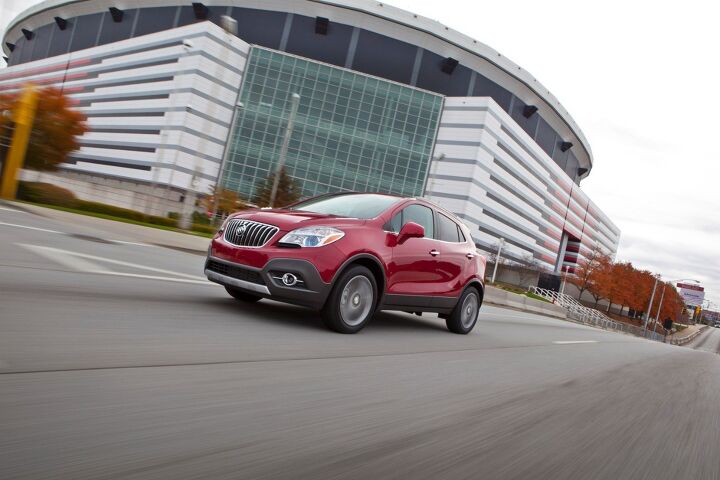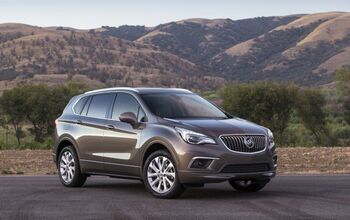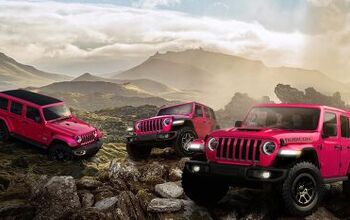The Verano Is Dead, But Should Buick Sell Cars In America At All?
The Verano, Buick’s four-year-old entry-level sedan based on the previous-generation Chevrolet Cruze, will join the Century, LeSabre, Park Avenue, Reatta, Riviera, Roadmaster, Skylark, and numerous other cars in Buick’s mass grave at the end of the 2017 model year (hopefully far, far away from Harley Earl’s resting place).
Automotive News reported yesterday that its GM sources say the Verano, while living on in China, won’t be renewed on this side of the Pacific. Verano volume tumbled 30 percent between its U.S. sales peak in 2013, the Verano’s second full year, and 2015. Buick is now generating nearly six in ten U.S. sales with just two crossovers, while the brand’s four car nameplates combined for a 3-percent drop during the first four months of 2016. That’s before Buick adds the Envision to the middle of its crossover lineup and before Buick kills off the entry-level car that generates more than one-third of the brand’s passenger car volume.
So, if it’s not too impertinent to ask, not too morbid or irreverent to inquire, how long before Buick discontinues its whole North American car division in a quest to become America’s crossover-ized answer to Land Rover?
Oh, we know the U.S. market is far from Buick’s most important. If Buick, with record global sales in calendar year 2015, is going to develop traditional sedans for the Chinese market anyway, you argue, it won’t be the most difficult task to sell those cars here, as well. And that would be a terrific argument if there wasn’t proof in the Verano’s not-yet-confirmed U.S. cancellation that General Motors is perfectly willing to develop a Buick car that won’t be sold in America. The Verano’s not the only one, either.
Closer to home, Buick also has a new sedan in the hopper. The 2017 LaCrosse is a looker. Better yet, it looks decidedly premium, in accordance with Buick’s desire to be taken seriously as a premium brand, and not just an upmarket Chevrolet.
But this is 2016, not 2002. Buick won’t sell 160,000 LeSabres and Park Avenues LaCrosses in 2016. The previous LaCrosse averaged little more than 50,000 annual U.S. sales between 2011 and 2015, and sales plunged 31 percent between 2010 and last year.
A handsome car? The 2017 LaCrosse certainly is, but it won’t be a common car. Rivals direct and indirect are all in the same boat, failing in recent years to match the level of demand they achieved a decade ago.
The next LaCrosse isn’t the only new Buick car. Buick’s Opel Cascada twin produced 2,487 sales in 2016’s first four months, including an April in which the Cascada narrowly outsold the Mazda MX-5 Miata. But we know better than to believe a convertible can save a car brand.
As for the current Regal, sales of which the Verano cannibalized, Consumer Reports praise hasn’t turned into marketplace acceptance. Regal sales are rising modestly in 2016, but Buick’s U.S. dealers are on pace to sell half as many Regals in 2016 as they did in 2011, the current Regal’s first full year on the market.
Yet as the four-pronged Buick car lineup’s U.S. sales volume fell 3 percent in the first-third of 2016 — and the non-Cascada Buick car trio’s sales predictably tumbled 11 percent — the brand’s two crossovers combined for a 12-percent year-over-year increase.
The Encore, Buick’s best seller is up 21 percent to 23,808 units, more than the Verano and LaCrosse combined.
Buick’s nearly decade-old Enclave flagship is recovering (slightly) after last year’s (slight) decline and is on track for its highest-volume U.S. sales year ever.
These two models produced 54 percent of Buick’s volume in the first four months of 2015 — and 57 percent one year later. Despite the car division’s losses, brand-wide Buick volume is up 5 percent in 2016, outpacing the industry as a whole.
But these are current figures, not taking into account the Verano’s demise and the Envision’s arrival. IHS Automotive anticipates an extra 38,000 Envision sales in calendar year 2017. Based on the steady introductions of SUVs/crossovers at other brands and the utility vehicle market’s continued growth, it’s safe to assume the Envision won’t eat into Encore and Enclave sales totals.
Add 3,100 monthly sales of the incoming Envision to Buick’s total, subtract 2,700 monthly sales of the departing Verano from Buick’s total, and suddenly Buick’s U.S. operations aren’t crossover-heavy — they’re crossover-dominant. The Encore and Enclave now account for 57 percent of Buick’s sales. In the incoming Envision/departing Verano scenario just described, nearly three-quarters of Buick’s sales will come from the crossover department.
Incidentally, that’s not completely out of sync with many premium players. Through the first-third of 2016, 68 percent of Lincoln’s sales derived from SUVs/CUVs, 64 percent at Acura, 58 percent at Cadillac, 81 percent at Jaguar-Land Rover, 58 percent at Infiniti, 57 percent at Lexus, 62 percent at Porsche, and 71 percent at Volvo.
Most mainstream brands, on the other hand, continue to sell more cars than SUVs/CUVs, although the difference is decreasing in size.
Regardless of the formulation at rival brands, Buick’s cancellation of the Verano is undeniably caused by the brand’s rapid utility vehicle growth rate. How can Buick sell an upmarket small sedan when there are newer, high-volume small sedans challenging the Verano in terms of luxury content? How can Buick sell an upmarket small sedan when, more and more, upmarket buyers are looking for greater ride height, liftgates, and all-wheel drive?
Indeed, if the trend that’s causing the Verano’s North American demise is further cemented by the Envision’s arrival, one must wonder whether Buick’s other cars will, sooner than later, suffer a similar fate.
[Images: General Motors]
Timothy Cain is the founder of GoodCarBadCar.net, which obsesses over the free and frequent publication of U.S. and Canadian auto sales figures. Follow on Twitter @goodcarbadcar and on Facebook.
More by Timothy Cain
Latest Car Reviews
Read moreLatest Product Reviews
Read moreRecent Comments
- Jalop1991 There is no inflation. Everything is cheaper than it was 5 years ago. SHRIMP AND GRITS!
- ChristianWimmer Exterior and interior look pretty flawless for such a high mileage car. To me this is an indication that it was well-maintained and driven responsibly. It’s not my cup of tea but it’s bound to find an enthusiastic owner out there.And with ANY car, always budget for maintenance.
- Fred I'm a fan and watch every race. I've missed a few of the live races, but ESPN repeats them during more reasonable hours.
- Mikesixes It has potential benefits, but it has potential risks, too. It has inevitable costs, both in the price of the car and in future maintenance. Cars with ABS and airbags have cost me at least 2000 bucks in repairs, and have never saved me from any accidents. I'd rather these features were optional, and let the insurance companies figure out whether they do any good or not, and adjust their rates accordingly.
- Daniel Bridger Bidenomics working.




































Comments
Join the conversation
IIRC, at the time the Verano was launched, there was comment that it was too close to the Regal in size and price. Amazingly (and not just to me) the car was fairly successful. Now that car sales are on the downhill slope, it makes sense to cut one of the models loose. Honestly, I never imagined the Regal would have made the cut. I had my 2009 Pontiac in for it's 100K mile service recently. I was given a 1200~ mile 2016 Regal Turbo 2.0L S. A very nice car, very much in the same vein as the G6, but far better assembled and equipped. I've only ever sat in Veranos, but the first time I sat in the Regal Turbo, I was hooked. I can't say the same about the Verano. I agree with another poster further up the thread that Buick should continue to sell cars wherever they can. I believe we will hit peak SUV at some point in the next several years. I look back to the years the minivan was on the upswing: every manufacturer was so anxious to get in on the action they even sent weird home market models over here that barely fit into the FWD minivan ideal. That statement includes a couple of domestic makers, too. Before long, everyone will have their SUV, look around and decide they want something else. It will be good to have a few car models around then...
GM had product differentiation down to a science, then as Jack B wrote a while back watered it down by introducing options and tarted up models that blurred all distinctions. Combine that with poor quality products and the mass marketing/downmarketing/downsizing of Cadillacs and you had a recipe for disaster. I say that with sales and profits up due to a current boom market that GM should totally restructure and redefine and maybe reintroduce some old marques. Of course due to their bureaucracy and dealer related issues this cannot happen. 1. Cadillac: high end luxury vehicles North American market centred 2. Buick: Chinese/Asian market 'near luxury'vehicles 3. Chevrolet: mass market front wheel drive vehicles, North American market centred 4. Opel/Vauxhall/Oldsmobile: 'world' vehicles, sold worldwide 5. Holden/Pontiac: rear wheel drive performance centred cars, sold in North America and Australia (and maybe the UK) 6. GMC: trucks and cargo vans, sold worldwide